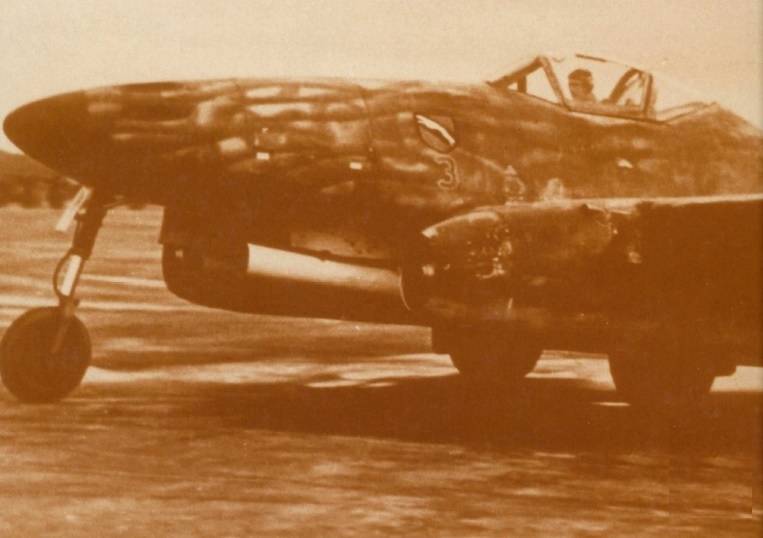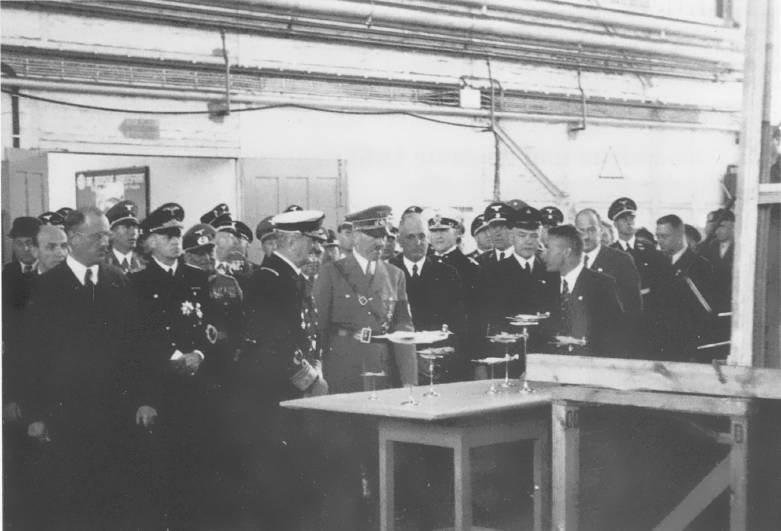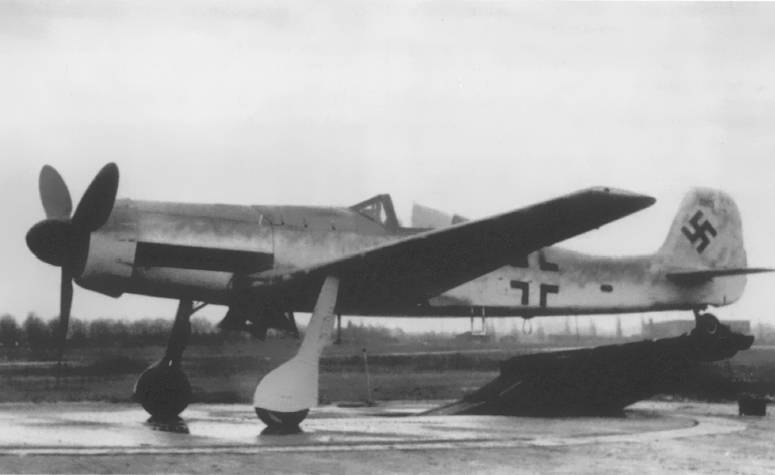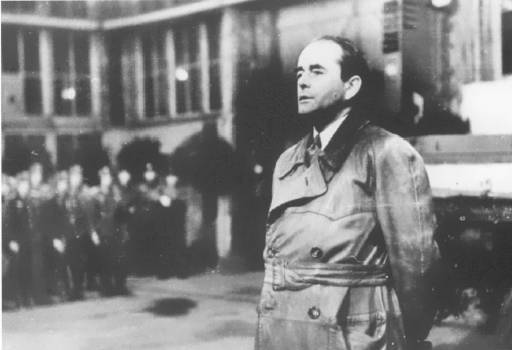“Luftwaffe in 45. Recent flights and projects. Introduction

This text is an abridged translation of the book “Luftwaffe'45. Letzte Fluge und Projekte ", made by a colleague of NF, which is translation author many interesting topics concerning the air forces of Germany. The illustrations are taken from the original of the book, the literary processing of the translation from German was made by the author of these lines.
After the catastrophe at Stalingrad, the situation in Germany as a whole deteriorated, and at the same time the position of the Luftwaffe as such became worse. In the course of the battles in the East and in Italy, the Allies managed to occupy the territories occupied by the Germans more rapidly, forcing the Wehrmacht to go on the defensive. At the same time, since the summer of 1943, the 8 Air Force, the US Air Force, with a force that has never been shown before, began to launch successful strikes against ground targets in Europe, including targets that had no military significance. At the same time, the four-engined bombers of the bomber command of the British air force began launching night strikes against major German cities. On Churchill's orders, the British Air Force took more and more part in the total air war, with the aim of not only undermining the morale of the Germans, but also reducing the efficiency of industrial enterprises, which, theoretically, should have caused the greatest possible war weariness.
The massive use of escort fighters and the increasingly powerful defensive armament of the American four-engine bomber B-17 and B-24 at that time were a decisive factor in the air war. The actions of the Allies forced the Luftwaffe to spray fighter squadrons on the territory of the country, since the strikes were carried out over large areas. In 1943, heavy bombing of Hamburg caused fire storms to appear in the city, which demonstrated to the Luftwaffe’s leadership what the enemy’s capabilities had.
In 1944, more and more cities and industrial enterprises in Germany were turning into ruins and ashes, while the morale of the population was falling, and all industrial aspirations aimed at increasing the output of weapons systems faced significant obstacles. From the beginning of 1944, large formations of American bombers began bombing aircraft manufacturers even during daylight hours. Then followed powerful blows to shipbuilding yards, power stations and, above all, to enterprises producing synthetic fuel. Nevertheless, the German industry in the implementation of the programs "223" and "224" managed to significantly increase the production of fighters. The number of monthly produced fighters gradually reached thousands, rushing to the 3 000 indicator. It was believed that such an increase would finally have an effective impact on the Allies.

At Blohm & Voss in Hamburg.
Mass production of fighters could not be organized without solving some problems, in particular, the production of a sufficient amount of aluminum and other materials necessary for aircraft manufacturing. First of all, the possibility of increasing the production of synthetic fuel would make it possible to carry out training of aircraft pilots that have justified themselves, but since 1944, the duration of training for aircraft crews has been steadily reduced, which could not but affect the efficiency of the Luftwaffe. The constant strikes of enemy bombers against the infrastructure of Germany led to a decrease in the volume of production, and from the middle of 1944, no changes were expected for the better. Operation Steinbock led to the fact that Germany’s resumption of air war over Britain caused the dispersal of the German forces. At the same time, the forces of the Allies steadily strengthened and increasingly surpassed the German side, so that from now on, at any time and in any place, the Anglo-Americans could deliver almost unpunished high-precision strikes. The delay in finishing the German aircraft with jet propulsion systems and numerous technical problems undoubtedly contributed to the Allied success leading to victory, and the development of a miracle weapons, which was part of the strategy of the Reich government, became a factor that would allow to achieve a turn in the course of the war.
Due to the almost unlimited possibilities of the Allies in the production of military equipment, and, accordingly, the limited capabilities of their opponents, the German industry, in opposition to mass American production, relied on German quality work. Tactical superiority in the air was to be achieved again through the use of aircraft with higher tactical and technical characteristics. Due to the lack of strategic reserves of the necessary raw materials, there was no reason to hope for an abrupt increase in the production of military equipment, and aviation the squadrons were forced to gradually switch to military equipment with higher tactical and technical characteristics, which would make it possible to successfully fight not only the R-47 and R-51 fighters that were in service with the allies, but also against four-engine bombers. The production of anti-aircraft missiles, contrary to plans, was slowed down, and the beginning of their use was planned already in mid-1944. This also applied to their potential carrier aircraft, which were supposed to use these missiles, as well as to other weapons, for example, automatic turret guns MG-213.
In August, the 1944 of the Luftwaffe High Command (OKL) established a qualitative composition of Luftwaffe formations that are relevant to the near term, by December 1945.

High-altitude interceptor Ta-152 N.
By the end of the 1944 summer, nine combat squadrons of bombers were armed with obsolete Ju-88 and Ju-188. According to the plan, by the end of the year only eight such squadrons were to remain, and with high probability during the next, 1945, two of these squadrons were to be disbanded so that by the end of 1945, the Luftwaffe there were only six bombers to remain in service of which the Ju-388 K-1 aircraft were supposed to arrive. All squadrons armed with Do-217 type bombers were to be disbanded as soon as possible, approximately by October 1944, according to the new view of the German air force leadership. Ju-388 K-1 bombers should have replaced Ju-88 А- 17, which were in service with the bomber squadron KG 26. In the period from December 1944 to May 1945, three squadron groups were to receive the Ju-188 and Ju-388 K-1 types of aircraft in versions of torpedo bombers (LT). These three groups were planned to be used over the North Sea and over the Arctic Ocean. The fourth group of this squadron, as planned in September 1944, was not supposed to take part in the fighting in full force. Not only units that were armed with Non-177 aircraft capable of carrying guided aerial bombs were to be disbanded, but also units equipped with Do-217 K-3 bombers with the Kehl system. There were no chances left for divisions armed with FW-200 C aircraft. Since it was impossible to predict how much more can be used for bombing aircraft with Do-217 and Non-177 types, 37 units among them with the Kehl system, as well as 135 bombers were scheduled to be sent to the OKL reserve.
It was planned to further reduce the number of non-111 planes in the combat units, while the latter were not planned to be replaced. The production of aircraft of the type Non-111 H was suspended, the work was reduced only to the production of spare parts necessary for their repair.
The planning VI planned for combat use was to be put into service with Group III / KG3 in the amount of ten monthly. It was not known how long it would be possible to use bomber groups with non-111 H-20 aircraft on the Eastern Front, and OKL planned to use the latest Me-262 A-1 / B or A-2 aircraft in two such bomber groups. In December 1944, the number of groups armed with these machines should have been increased to three. The number of connections with the Me-262 in the version of high-speed bombers at the latest by March 1945 should have been reduced to two, and the first such squadron with jet bombers should be KG 76. Since November, 1944 was planned to equip Group III / KG 76 with jet bombers Ar-234 B-2. From February 1945. OKL planned to arm the KG 76 squadron first with Ar-234 C-3. From July to the end of 1945, it was planned to arm the Ar-234 C-3 or C-5 14 air groups as a whole. The first bomber group with Do-335 type aircraft in the Luftwaffe was expected by July 1945. For the period up to December 1945, OKL planned to use the first and possibly the only squadron armed with aircraft of this type. Ju-287 was to be the first heavy Luftwaffe jet bomber. The use of the first group with such machines was expected from July 1945, the next two similar groups were planned to start using 31 on December 13, at the latest.
Reich Minister of Weapons and Ammunition A. Speer

and his deputy, certified engineer Saur (Saur), from 1 August 1944, using his extensive experience, had to deal with the supply of weapons and other necessary resources for the Wehrmacht, the SS and the Luftwaffe. General Staff-Engineer R. Lucht was appointed responsible for the operational implementation of the decisions taken. The control over the implementation of the aircraft construction program was shifted to a senior engineer Lange. Responsible for all measures necessary to ensure reliable protection against bombs from aircraft building and engine building enterprises, was appointed a graduate engineer Kammler, the group of the Fuhrer of the SS.
The measures taken have allowed to simplify the production of certain types of products and significantly improve the coordination of transportation and further processing of both finished products and semi-finished products. The creation of the Fighter Headquarters, according to Speer, made it possible to avoid various frictions during the implementation of weapons and ammunition production programs. The leadership of the headquarters of the Reich Minister carried out from March 1 to August 1 1944.
The first order was an instruction to organize the production of aircraft such as the Ju 287 type and to increase the production of Ar 234 type aircraft as quickly as possible, as well as to increase the production of light fighters of the type He 162 to 1 000 units per month. Also, along with other programs, there was a demand for the organization of production of Me 262 А-1 type aircraft as quickly as possible. The adoption of these measures could allow in the coming months to increase the production of airborne combat equipment to the required amount, while at the same time the shortage of fuel and the bombing of the Allies in industrial enterprises and means of transport had a negative impact on the implementation of the above measures. According to the plan, only from January 1945 could the goals be achieved, but by this time all production in Germany was on the verge of complete collapse. The occupation by opponents of large areas of the Reich turned out to be fatal for Germany, and as a result, the Alpine Fortress did not know what to expect in the future.
At aircraft manufacturing enterprises and further, the qualitative parameters of the products manufactured prevailed over the quantitative ones. Research, development and testing were aimed at providing high quality products. During the first two months of 1945, in the process of testing new product samples, interruptions regularly occurred due to the actions of opponents, and at the end of February 1945 came to understand that everything that the German aviation industry was trying to realize was due to air strikes and fuel shortage is impossible to implement.
12 March 1945, the head of the Technical Aerial Equipment Department (Chef TLR) demanded both the release of new airplanes and missiles, and their subsequent development of the transition to emergency measures, as a result of which it was possible to supply the produced aircraft with the necessary quantities for testing. In the test center in Rechlin (Rechlin), test pilot Müritz (Müritz) was engaged in testing the highest priority of aircraft type Me 262, designed to protect the territory of the Reich aircraft type I and II, as well as performed under the "flying wing" of the aircraft type 8-229 . In addition, it was necessary to complete the testing of helicopters of types 8-223 and 8-282. In the foreseeable future, it was not possible to count on bringing the paired Do 335, which received the designation Do-635, and already in the middle of March 1945 this program was curtailed. In terms of engine-building, piston engines such as the DB 605 D and BMW 801 TS have become lower priority, instead of them jet engines have become the absolute priority.
In addition, no further work was continued on navigation equipment and control systems such as TSA 2D and BZA, on Lotte 7H and 8 sights. Toroewitz began work on automatic bomb raisers and special devices SG 113 A, SG 117 and SG 500. At the same time, they began to develop a new type of gyro sights, 1 and 2 anti-tank missiles, a Werfergаnate 42 launcher, and R 100 BS (Brond-Splitter) missiles. The development of gun carriages for heavy automatic guns of the MK 103 and MG 151 / 20 types was recognized as promising. In Kartshagen (Kartshagen), the 8-344 (Kramer X-4) missile-guided missiles began to be tested, the tests of which were to be completed as soon as possible. In addition to these samples, the development of 8-347, 8-246 and 8-117 types of guided missiles received the highest priority. As part of the Reich airspace protection program, it was necessary to bring the BMW 003 R-type jet propulsion systems, intended for Me 262 C-2b type aircraft, as soon as possible. Were also taken steps to ensure that in the coming weeks it was possible to start using jet bombers of the type Ar 234 B-2 with guided bombs like Hs 293.
At the test center in Travenmünde (Travemünde), then much attention was paid to the rotating Kurt bomb, the Mistel 5 air coupling, which in practice should be tested in the KG 200 squadron, as well as the planned 10,11,30 and 40 air torpedoes. In addition, the test of BT 1400 super-heavy torpedo bomb also had to be completed. The tests in Vernuikhen (Werneuchen) of all the radars created under the emergency program were in the final stage, but due to the small number of test samples prepared for testing, these tests were not completed. Only in Rekhlin, tests could continue until mid-April 1945, but here too heavy bomb attacks and cannon-machine-gun fire from enemy aircraft flying at a minimum height resulted in the termination of tests, as a result of which many samples of miracle weapons did not leave the drawing stage.
A long-range missile intended for strikes against America and its highly effective warhead required several more months for final refinement.
From all of the above promising research and developments in the field of aviation, there was little use, because by that time there was no fuel for testing new equipment, since in the summer of 1944, Allied aviation launched bombing of oil refineries producing synthetic fuel. 25 March 1944 The head of the Wehrmacht High Command (OKW), Field Marshal V. Keitel (Wilhelm Keitel) drew the attention of A. Speer to the fact that the demand for aviation fuel was provided only by 66%, and the continuation of the war was complicated by the lack of fuel. As for the aviation fuel used by the Luftwaffe, 92% of it was synthetic. But the quality of most aviation gasoline remained at the level of 1936, and, as a rule, the octane number of aviation gasoline was equal to 87. Since May, Allied Aviation 1944 has specifically launched the bombing of enterprises producing aviation gasoline of all grades, as a result of which the production of liquid fuel decreased by 22% by June 90, and the bulk of the fuel reserves in the storages were consumed approximately by August of the same year.
30 June 1944. Hitler in his memorandum demanded to do everything possible to restore the previous level of production of synthetic liquid fuels. At this time, the ratio of forces in the air was 7: 1 in favor of the allies, and in this already difficult situation, the availability of adequate reserves of liquid fuel for German aircraft was extremely important so that German aircraft could protect at least the territory of Germany proper.
In the period from July to December, 1944 planned to produce monthly 207000-230000 tons of aviation gas, but in fact the Germans were able to produce only 17000-49000 tons. In December, 1944, due to the Allied bombings, the amount of aviation gas produced fell to 26000 tons. Even in the conditions of austerity of aviation gasoline, German aviation monthly spent 40000-50000 tons of gasoline. Since January 1945, the production of aviation gas has almost ceased, the surviving production facilities could produce only 11000 tons of gasoline per month. In February, only 1945 of aviation gasoline was produced by 1000, and in the next two months, enterprises located on the earth's surface could not produce liquid fuel at all.
In March, 1945 was a few underground plants, for example, in Upper Austria near Ebensee (Ebensee), although they could produce liquid fuel, but by this time there was no necessary raw material for the production of high-octane aviation gasoline. Other plants that produced liquid fuels and were created in accordance with the Geilenberg- “Wüste” program in Württemberg (Württemberg) or small oil refineries (from “Ofen I” to “OfenXL”) produced only a small amount of it. The fifth letter concerning the state of enterprises for the production of liquid fuel, dated 19 January 1945), contained information according to which it was not possible in the near future to restore the production capacity for the production of liquid fuel. For the Luftwaffe, this meant that in the coming months the aircraft would be left without fuel, so all the hopes placed on the miracle weapon lost their meaning.
Early in the morning of 16 December, 1944 was the German ground forces of the 8 Army Group under the command of Field Marshal W. Model (Walter Model) on the front line between Monschau (Eifel) and Echternach (Echternach), using the surprise factor, launched an offensive operation and , although they achieved some success, the ultimate goal of the offensive, which included the occupation of Antwerp, was not achieved. Bastogne, surrounded by a small town, was gradually occupied by American troops, and German units were pushed back to their original positions. Gradually, the weather began to improve, with the result that the Allies were able to use the full potential of their aircraft. Thus, the German offensive in the Strasbourg area (Straßburg), which began on December 31 1944 - the beginning of 1945, led to a slight success. The air confrontation at the end of 1944 was accompanied by the secret preparation of German aircraft for a massive attack on the airfields of the Allies. This operation is called the Bodenplatte ("Bodenplatte"). The high command of the Luftwaffe hoped during the operation to reduce the pressure exerted by Allied aviation in the west of the Reich.
Initially, massive attacks on Allied airfields were planned for early morning 1 on January 1945, but due to weather conditions, the start of the operation was postponed to a later date. The 3 Fighter Division was to support squadrons that were directly involved in the operation. Fighter squadrons of JG 2, JG 4 and JG 11 were located on the middle Rhine. There it was also planned to transfer the squadron of JG 53, which was based in the area of responsibility of the 5 th division of fighters. Squadrons of air squadrons JG 104, SG 4 and NSGr took part in the operation. 20, as well as the KG 262 squadron equipped with Me 51 type aircraft. According to German sources, during the operation on the ground and in the air, it was planned to destroy about 500 enemy planes, another about 100 aircraft should have been damaged.
Due to the strictest secrecy of the operation, Luftwaffe ground units were not promptly warned, including the calculations of FuG 25-a radar stations and anti-aircraft artillery units. As a result, when flying over enemy territory and returning to their bases, the German air force lost 139 pilots. The fate of the 107 pilots was not known, the 34 pilots were injured or left their aircraft with parachutes. During the two or three weeks following the attack on their airfields, the Allies managed to compensate for their losses, and for the Luftwaffe the irretrievable losses of well-trained pilots were heavy and in the following weeks these losses made themselves felt — large-scale operations in air battles over the Rhine were impossible . To this it should be added that the Red Army 28 on January 1945, using significant superiority in forces, launched a major ground-based offensive operation, and soon Germany was deprived of an industrial area with centers in Boytfien, Gleiwitz, located in Upper Silesia and Katowice (Kattowiitz). The enemy constantly moved westward towards Marish-Ostrau (Mahrisch-Ostrau), and soon almost all lines of communications were under the control of Soviet troops. The city of Breslau (Breslau) was declared a fortress, in the areas of Steinau-Glagau-Schwibus-Mezeritz (Steinau-Glagau-Schwiebus-Meseritz) was a large-scale struggle, Warthegau (Warthegau) was surrounded. The enemy advanced further the Berlin-Schneidermühl-Dirschau branch line (Berlin-Schneidermuhl-Dirschau). In addition, the Red Army surrounded Elbing in East Prussia (Ostpreußen). In the city of Marineburg (Marienburg), which was the production center of Fw 190 D-9 type fighters, the noise of fighting was heard everywhere. Soon the Red Army cut the link between East and West Prussia. In East Prussia, German troops were pushed back to the line Wormdit-Zenzburg-Rustenburg-Königsberg (Wormditt-Sensburg-Rastenburg-Königsberg). The capitals of the southern and northern parts of the region were surrounded. In Kurland, surrounded by German units, led by Colonel-General Gilpert (Hilpert), deprived of the supply of fuel and the necessary materials, with the help of the Luftwaffe in six consecutive battles managed to repel all attacks of the Red Army.
Despite the enemy’s considerable superiority in forces, the group managed to hold out until May 1945. In February 1945 on the ground theater of operations the German units still defended, but the Reich air forces, receiving less and less fuel, by the end of 1944. could less and less take part in battles. In order to prevent the Allies from advancing deep into Germany, or at least slowing down this process, absolute priority was given to the support of German troops from the air. The Luftwaffe high command tried to better provide its units on the Eastern front with everything necessary, often this was done even by reducing the activity of German fighter aircraft over German territory.
Information